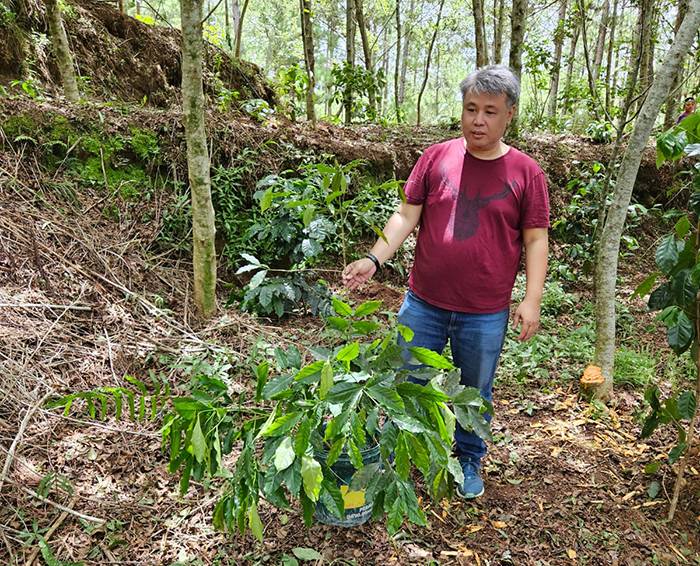How coffee became an instrument for peace in Mindanao
I feel like a voice crying in the wilderness,” says Richard Watanabe. “I’ve spent 16 years promoting coffee. My hair was still black then.”
Watanabe was speaking during the kickoff event for Biyaya Sustainable Living Festival, of which he’s a co-founder. He’s also the executive director and founder of Coffee Heritage Project, CEO and president of Coffee Science Center, representative for Asia of the Paris-based Agence pour la Valorisation des Produits Agricoles (AVPA) and head of the Philippine National Coffee Congress, among others.
No wonder his feelings of desolation, the look of weariness are etched on his otherwise cheerful face.

And yet, his passion for promoting Philippine coffee hasn’t wavered. On the contrary, his advocacy has grown exponentially. Now, it also includes promoting cacao, the heritage crafts and practices of Filipino communities, sustainability and environmental protection.
“We started out helping the coffee farmers, but then their relatives were weavers creating native arts and crafts. They even joined in the dancing during one festival, so we decided to help them, too,” says Watanabe.

All these will soon come to a riproaring event during the Biyaya Sustainable Living Festival at Parqal in Aseana City, Parañaque on March 14-16. With the festival, the group hopes “to nurture our cultural heritage while advancing environmental sustainability” through craft, coffee and clothing.
“It’s a platform for all these groups to come together as one,” says Tatti Fortuna-Miranda, festival director and CEO/founder of TAHI. “We have to highlight them so we don’t lose our crafts.”

In addition, the project aims to bridge the gap between producers and consumers.
Bess Howe adds, “We hope to inspire the younger generation to continue these crafts.”
The festival will feature more than 200 exhibitors, including coffee, cacao and coconut farmers, as well as craftsmen, fabric weavers and local fashion designers. There will be interactive workshops and live demonstrations of artisanal crafts such as cloth weaving and basket making. Fashion shows will feature modernized and updated traditional wear. Cultural dances, Baybayin writing (an ancient Filipino script) and traditional tattoo painting will be showcased as well. In sum, the festival promises to be both fun and educational.

One of those expected to come is Jeannie Laccay, who has done extensive research on Philippine textiles and weaving. Half-Isinay and half-Ilocano, she has tried to revive the lost art of the Isinays’ native weaving, and now makes handwoven baby wraps and slings, neckties and shoes.
Meanwhile, coffee aficionados will be delighted to know that during the festival, there will also be free tastings of coffee.
And they won’t be disappointed. After all, Philippine coffee has won several international awards. Most recently at the Paris conference of the AVPA, George Dapliyan’s Southern Sagada coffee won a Gourmet Bronze Medal in the “Acidule Floral” category; Martin Macalintal and Nina Guinto’s Batangas coffee won a Gourmet Medal in the Unique Exceptional Coffee Category; Andrew and Mary Tomeg and Felipa Villicana’s Northern Sagada coffee won a Gourmet Silver in “Acidule Floral”; and Rebecca Gacayan’s Sultan Kudarat coffee won a Gourmet Medal for “Well-Balanced Coffee.”
Indeed, Philippine coffee has come a long way. A former coffee trader, Watanabe narrates a life-changing experience he once had in Sagada. “The people there were like ‘wala lang.’ They had no idea what the world was about. It was like they would just simply say ‘may coffee kami, we drink it, we sell it when there are buyers.’”
He goes on to relate, “I asked for some coffee and they said there was none available. So they got the village roaster to prepare the coffee and while he was doing so, I noticed that he used particular types of wood and grass for roasting the beans. When I drank the coffee, it was as if I was drinking the whole valley! The taste was so pure, the air so clean, the water very fresh. The aroma was fine and the flavor was smoky but not burnt. It was like the whole land was encased in the coffee.”
“No coffee had ever impacted me that way,” he recalls. “I felt this had to be shared.”
Since then, Watanabe has taken epic journeys in search of more heritage coffee. He has found equally transformative ones in Batangas, Rizal, Sulu and Mindoro.
Coffee can even be an instrument for peace. In Mindanao, he narrates, the farmers would sometimes ask the Abu Sayyaf to stop the fighting for three hours while they harvest their coffee. In agreement, the Abu Sayyaf would not fire a single shot while the farmers gathered as much harvest as they could. For three precious hours, there would be peace.
“I’ve tasted their coffee and it was very floral. It was like lavender,” Watanabe marvels.
He defines heritage coffee as being generational. “It should speak of an identity and should speak of the land.”
“Our history is so tied in with coffee,” he believes. He cites the example of a French man who started a coffee farm in the 19th century, after being given the rights to it by the Spanish crown. There was also a German who lived in Tawi Tawi in the 1850s. He found the land not suitable for farming, so he went to Basilan where he successfully cultivated a coffee farm.
“Coffee is the story of us,” says Watanabe.
And more of that story will be revealed—and experienced—during the forthcoming Biyaya Festival. With the cloth weavers, basket makers, coconut and cacao farmers also showcasing their products, Biyaya’s vision of uplifting heritage industries may finally be fulfilled.
Then maybe Watanabe will at last be heard. He’ll no longer feel so desolate. He’ll no longer feel like a voice crying in the wilderness.
* * *
Biyaya Sustainable Living Festival will be held March14-16, at Parqal, Aseana City, Parañaque.


